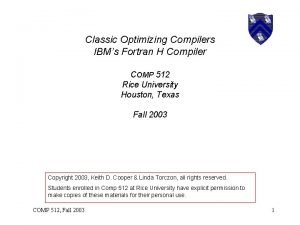Optimizing parallel reduction in CUDA Follows the presentation















- Slides: 15

Optimizing parallel reduction in CUDA Follows the presentation of Mark Harris - Nvidia

Parallel Reduction �Tree based approach in each thread block �Use multiple thread blocks To process large arrays To keep all the SMs on the GPU busy Each block process a portion of the array

Parallel Reduction �CUDA has no global synchronization �Decompose the process into multiple kernel launches

Optimization Goal �We should strive to reach peak GPU performance GFLOP/s for compute-bounded kernels Memory bandwidth for memory-bounded kernels �Reduction has very low computational need 1 flop/element �We should strive for peak bandwidth

Reduction v 0 // Reduction in the global memory __global__ void reduce. Kernel_v 0(unsigned int *g_idata, unsigned int *g_odata, size_t data. Size) { unsigned int lid = thread. Idx. x; // local id in the block unsigned int id = block. Idx. x * block. Dim. x + thread. Idx. x; // global id, base index of the thread block if (id >= data. Size) return; // do reduction in global memory for (unsigned int s = 1; s < block. Dim. x; s *= 2) { // modulo arithmetic is slow! if ((lid % (2 * s)) == 0) { if (id + s < data. Size)g_idata[id] += g_idata[id + s]; } __syncthreads(); } } // write result for this block to global memory if (lid == 0) g_odata[block. Idx. x] = g_idata[id];

Reduction v 1 �V 0 uses global memory to store intermediate results �Use shared memory instead

Reduction v 2 �V 1 : highly divergent branches

Reduction v 2 �Strided index and non-divergent branch

Reduction v 3 �V 2 memory access pattern

Reduction v 3 �Use sequential addressing instead

Reduction v 4 �In v 3 half of the threads are idle in the first iteration �Halve the number of blocks �Replace the single shared memory load with two global memory reads and the first add of the reduction

Reduction v 5 �V 4 is still limited by address arithmetic and loop overhead �Unroll the loops

Reduction v 5 �When s <= 32, only 32 active thread remained �These threads are in a single warp �Instructions are SIMD synchronous within a warp We do not need __synchthreads() If(tid < s) is also needless �Unroll the last 6 iterations of the loop Note: This saves useless work in all warps, not just the last one! Without unrolling, all warps execute every iteration of the for loop and if statement

Reduction v 6 �Complete unrolling �If we know the number of iterations at compile time, we can unroll the whole reduction Block size is limited to 1024 threads We use power of 2 block sizes Loop can be unrolled for a fixed block size �Use templates generic solution

Reduction v 7 �Algorithm cascading �Combine sequential and parallel reduction Each thread loads and sums multiple elements into shared memory Tree-based reduction in shared memory Each thread should sum O(log n) elements ▪ Or even more, try different parametrization
 Parallel reduction cuda
Parallel reduction cuda Reduction cuda
Reduction cuda How is economizing different from optimizing?
How is economizing different from optimizing? The fortran optimizing compiler
The fortran optimizing compiler Optimizing patient flow
Optimizing patient flow Define parallel forces
Define parallel forces It refers to the focal terminus of the fingerprint pattern?
It refers to the focal terminus of the fingerprint pattern? Parallel and non parallel structure
Parallel and non parallel structure Means
Means Parallel structure means using the same pattern of
Parallel structure means using the same pattern of Piso shift register circuit diagram
Piso shift register circuit diagram Parallelism definition literature
Parallelism definition literature Hát kết hợp bộ gõ cơ thể
Hát kết hợp bộ gõ cơ thể Ng-html
Ng-html Bổ thể
Bổ thể Tỉ lệ cơ thể trẻ em
Tỉ lệ cơ thể trẻ em




























